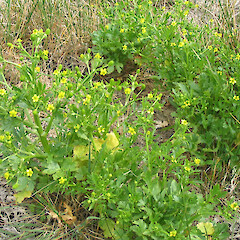Ranunculus sceleratus
Common name
celery-leaved buttercup
Family
Ranunculaceae
Flora category
Vascular – Exotic
Structural class
Herbs - Dicotyledons other than Composites
NVS code
The National Vegetation Survey (NVS) Databank is a physical archive and electronic databank containing records of over 94,000 vegetation survey plots - including data from over 19,000 permanent plots. NVS maintains a standard set of species code abbreviations that correspond to standard scientific plant names from the Ngä Tipu o Aotearoa - New Zealand Plants database.
RANSCE
Conservation status
Not applicable
Brief description
Fleshy, shiny-leaved buttercup, superficially looking like a young celery plant, but with small (0.5 to 1 cm diameter) 5-petalled pale yellow flowers and a cylindrical green fruit on a many branched flowerhead on the top of upright leafy stem (up to 60 cm tall).
Distribution
Scattered throughout both islands.
Habitat
Grows in wet places such as in ditches, along streams and around ponds and lakes (Landcare Research 1999).
Wetland plant indicator status rating
Information derived from the revised national wetland plant list prepared to assist councils in delineating and monitoring wetlands (Clarkson et al., 2021 Manaaki Whenua – Landcare Research Contract Report LC3975 for Hawke’s Bay Regional Council). The national plant list categorises plants by the extent to which they are found in wetlands and not ‘drylands’. The indicator status ratings are OBL (obligate wetland), FACW (facultative wetland), FAC (facultative), FACU (facultative upland), and UPL (obligate upland). If you have suggestions for the Wetland Indicator Status Rating, please contact: [Enable JavaScript to view protected content]
OBL: Obligate Wetland
Almost always is a hydrophyte, rarely in uplands (non-wetlands).
Detailed description
Annual; roots all fibrous. Stems stout, erect, glabrous or with sparse appressed hairs, (0.10-)0.30-0.60(-0.75) m tall. Basal and lower cauline lvs broadly ovate to reniform, cordate, deeply 3(-5)-lobed, glabrous or with fine appressed hairs, (10-)30-50(-80) × (15-)40-60(-100) mm; lobes obovate-cuneate, again shallowly 3-lobed and with crenate margins; petioles glabrous, (20-)50-100(-300) mm long. Upper cauline lvs similar; lobes becoming lanceolate, entire; uppermost lvs subsessile, not lobed, becoming finely appressed-hairy. Fls usually > 30 per stem, 6-10 mm diam. Pedicels erect, numerous, with sparse, fine hairs, sulcate, 25-40(-60) mm long at fruiting. Sepals 5, hairy, deflexed, acute, 3-4 mm long. Petals 5, pale yellow, broadly obovate, 3.0-4.0 × 2.5 mm; nectary single, 0.5 mm from petal base, pocket-like. Receptacle elongated, cylindric, hairy. Achenes (100-)200-400(-(00), in cylindric heads, glabrous, hardly flattened, weakly keeled, obovoid, weakly rugulose; body c.1.0 × 0.8 mm; beak < 0.5 mm long
Similar taxa
Differs from other buttercups by the combination of glabrous deeply 3 to 5 lobed leaves, upright not creeping growth habit, deflexed sepals and cylindric rather than globose receptacle.
Flowering
Spring to autumn
Flower colours
Yellow
Fruiting
Spring to autumn
Life cycle
Seed dispersed by water, animals or contaminated machinery.
Year naturalised
1878
Origin
Europe, South, West and Central Asia, Northern and tropical Africa
Reason for introduction
Unknown, seed or soil contaminant
Control techniques
Can be controlled manually, mechanically or herbicidally depending on situation.
Etymology
ranunculus: From the Latin ‘rana’ frog, meaning little frog and probably refers to the plants typical marshy habit where frogs abound
Poisonous plant
Resembles celery so sometimes mistakenly eaten. One of the most toxic buttercup species with the divided leaves causing blistering of the mouth and lips.
Attribution
Factsheet prepared by Paul Champion and Deborah Hofstra (NIWA).
References and further reading
Webb, C.J.; Sykes, W.R.; Garnock-Jones, P.J. (1988). Flora of New Zealand Volume 4: Naturalised pteridophytes, gymnosperms, dicotyledons. Botany Division, DSIR, Christchurch.
Popay et al (2010). An illustrated guide to common weeds of New Zealand, third edition. NZ Plant Protection Society Inc, 416pp.
Johnson PN, Brooke PA (1989). Wetland plants in New Zealand. DSIR Field Guide, DSIR Publishing, Wellington. 319pp.
Healy, A.J. (1982). Identification of weeds and clovers. New Zealand Weed and Pest Control Society Publication. Editorial Services Limited, Featherston. 299pp.







